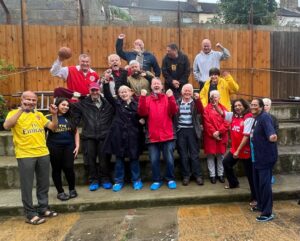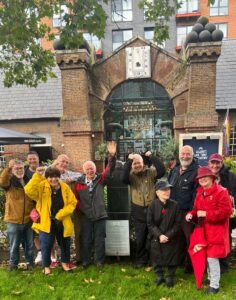- Another pundit going against the trend
- Swiss take drastic action against supporters; clubs fight back
By Tony Attwood
 I know – this article is about Arsenal’s history and as such should be on the Arsenal History Society site – but for me it was such a monumental event to be in the first group of Arsenal supporters to stand on the terraces of the Invicta Ground – Arsenal’s first proper stadium – in over 100 years, I really feel I’d like to share it with the all the readership of Untold Arsenal.
I know – this article is about Arsenal’s history and as such should be on the Arsenal History Society site – but for me it was such a monumental event to be in the first group of Arsenal supporters to stand on the terraces of the Invicta Ground – Arsenal’s first proper stadium – in over 100 years, I really feel I’d like to share it with the all the readership of Untold Arsenal.
So just for once Arsenal history is taking up a place on Untold Arsenal. But never fear, a discussion of today’s Community Shield game against Manchester City will follow here very shortly. And for me, and I think everyone else who was there, our visit to Arsenal’s first permanent football ground – was the Invicta Ground, a ground for which the record crowd was reputed to be 12,000, although I suspect that was something of an exaggeration. Or if the Invicta Ground really did hold 12,000, any contemporary concept of health and safety would have gone out the window with just half that number in attendance.
Of course, everything related to the pitch and the stand has now long gone, but some of the terracing remains, and it rather curiously forms part of the back gardens of a row of houses.
Obviously, these back gardens are private property, but through the dedication and hard work of members of the Arsenal Independent Supporters Association (AISA) contact was made with the residents and one family invited us into their house and then out the back to stand on the terrace.
It was an incredibly kind and generous offer, to have this bunch of football fans on a rather wet Saturday morning pouring through their house and out into the back garden, but they did it, were very pleased to see us and were very welcoming.
The Invicta Stadium was not of course the start of Arsenal – the club had been playing since its famous first match at the Isle of Dogs in 1886 (although the club was called Dial Square for that game), but this was its first proper stadium – its first permanent home.
It was during this time at the Invicta that a big split occurred at the club between those who considered themselves “professionals” – the middle-class elite who were capable of running a football club. They considered that the working men from the Royal Arsenal factories were not fit and proper people to run a club by themselves, and so a major dispute within the club arose at this time, as to its future.
As is the nature of many internal disrupts this one involved some very dirty tactics, but by the time the three-year lease on the Invicta ground was up, Royal Arsenal FC had managed to secure another stadium – the Manor Ground. The club moved into that ground in 1893, despite attempts by the rebels (the ones who felt that working men were not fit and proper people to be running a football club) to persuade the owner of the Manor Ground massively to increase the rent and effectively make it impossible for Arsenal to carry on.
What then happened, in short, was that Royal Arsenal moved to the Manor Ground, became a professional club and secured election to the second division of the Football League in 1893. Meanwhile, the rebels set up their own amateur team (Royal Ordnance Factories FC), and it took over the Invicta Ground as Royal Arsenal moved out.
Royal Ordnance Factories FC however did not flourish, and despite joining the Southern League could not attract the crowds needed to make the club a viable proposition. And so in October 1896, some six weeks into the season, the club ceased playing its fixtures and its record was expunged from the Southern League.
Royal Arsenal FC, however, joined in Football League in 1893, became a limited company and in accordance with the regulations about the use of the name “Royal” dropped that from its title, and became Woolwich Arsenal FC, playing in the second division.
In 1904 the club was promoted to the first division, but finances became difficult not least because the torpedo factory (from which many of the most active and vocal supporters were drawn), was moved to the Clyde, and the club became dependent on the financial support of one of its directors.
By 1910 he felt he could not keep on supporting the club as its financial difficulties were increasing. With closure threatened, Henry Norris, a director of Fulham, put up the money to keep the club going, and explored various options for the club including a merger with second division Fulham.
That merger was aborted when the League said although it would not prohibit such a move it would decide where the merged club would play – and that would be in the second division.
 With the clubs’ grounds being 17 miles apart it was clear few Arsenal supporters would go to Craven Cottage to watch the newly merged team, so the idea was dropped. Norris announced that if the crowds at Woolwich Arsenal did not increase he would move the club after one more year of financing it.
With the clubs’ grounds being 17 miles apart it was clear few Arsenal supporters would go to Craven Cottage to watch the newly merged team, so the idea was dropped. Norris announced that if the crowds at Woolwich Arsenal did not increase he would move the club after one more year of financing it.
The crowds did not increase, but Norris did in fact give the club three years, before moving the club from Plumstead to Highbury in 1913.
As for our day trip yesterday to the old ground, that finished with a walk to Dial Square – the factory within the Royal Arsenal from which the original Arsenal team (known for that first game as Dial Square) was drawn. There is a small memorial to the Arsenal football club at Dial Square and it can be seen bottom centre in this picture. Arsenal Independent Supporters Club is now looking into various ways in which the recognition of Arsenal FC’s association with Dial Square and the Royal Arsenal can be further developed.
You can join AISA either as a full member paying an annual fee or as an associate member (which is free). We are actively campaigning within the club on issues that our members feel are important, we have also our own banner at the stadium (the “Football should be an art” banner at the clock end). And we also run the Arsenal History Society with its own website which collects videos of historic games, and records the clubs’ anniversaries day by day.

Wow what a great read! When going home I once drove through the neighborhood and with the articles from the history site I could manage to make an image in my head about where the ground was situated behind the houses.
Thank you Walter. It really was a great day out.
Being myself a bit of a history buff , am always bemused when old artifacts and other memorabilia are found saved and well preserved . Hope that these be retained and be preserved for those who appreciate them.
It may sound a bit corny but standing on the Invicta Ground terraces was a bit of a ‘wow’ moment on Saturday; Seeing the terraces in situ and then walking around other key locations in South London with AISA ‘guides’ brought our history to life. A great day – thanks to all at AISA for making it possible.